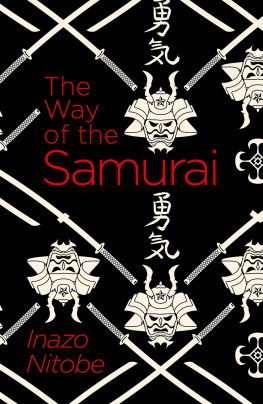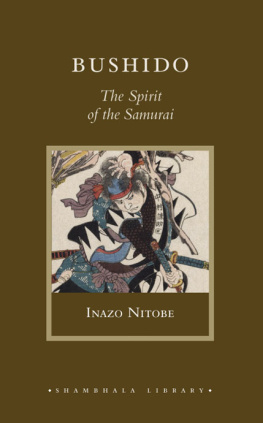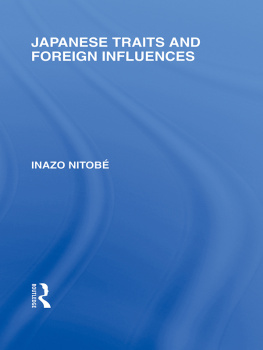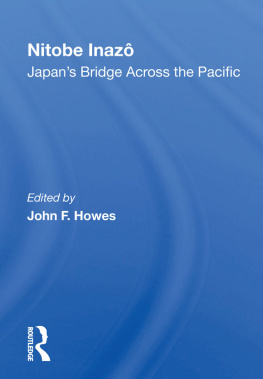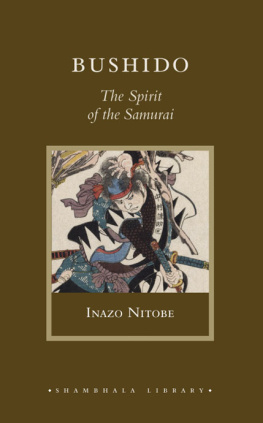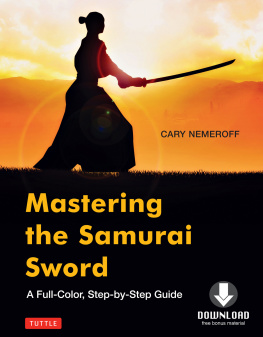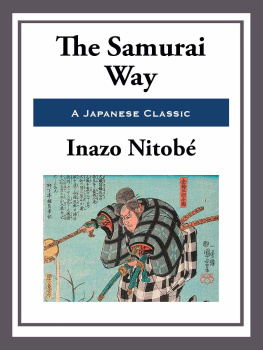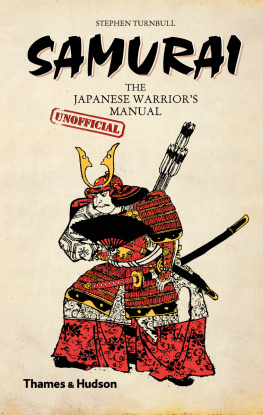Inazo Nitobe - The Way of the Samurai
Here you can read online Inazo Nitobe - The Way of the Samurai full text of the book (entire story) in english for free. Download pdf and epub, get meaning, cover and reviews about this ebook. year: 2020, publisher: Arcturus Digital Limited, genre: Religion. Description of the work, (preface) as well as reviews are available. Best literature library LitArk.com created for fans of good reading and offers a wide selection of genres:
Romance novel
Science fiction
Adventure
Detective
Science
History
Home and family
Prose
Art
Politics
Computer
Non-fiction
Religion
Business
Children
Humor
Choose a favorite category and find really read worthwhile books. Enjoy immersion in the world of imagination, feel the emotions of the characters or learn something new for yourself, make an fascinating discovery.
- Book:The Way of the Samurai
- Author:
- Publisher:Arcturus Digital Limited
- Genre:
- Year:2020
- Rating:3 / 5
- Favourites:Add to favourites
- Your mark:
- 60
- 1
- 2
- 3
- 4
- 5
The Way of the Samurai: summary, description and annotation
We offer to read an annotation, description, summary or preface (depends on what the author of the book "The Way of the Samurai" wrote himself). If you haven't found the necessary information about the book — write in the comments, we will try to find it.
The Way of the Samurai — read online for free the complete book (whole text) full work
Below is the text of the book, divided by pages. System saving the place of the last page read, allows you to conveniently read the book "The Way of the Samurai" online for free, without having to search again every time where you left off. Put a bookmark, and you can go to the page where you finished reading at any time.
Font size:
Interval:
Bookmark:
First published in 1900, Inazo Nitobes classic exposition of the Way of the Samurai was written at a time when Japan was undergoing a profound transformation as it emerged from the feudalism and closed doors seclusion of the Edo Period to become a modern nation. Originally written in English for Western readers and published under the title Bushido: The Soul of Japan, the present book was one of the first major works to offer an insightful account of the principles underlying the samurai tradition and the influential role these had played in the moulding of Japanese culture and the character of the Japanese people, both of which appeared alien to contemporary Western eyes. As such it was read by many influential foreigners, among whom may be counted President Theodore Roosevelt, President John F. Kennedy and Robert Baden-Powell, founder of the Boy Scout movement, who is said to have studied the educational techniques of bushido while writing Scouting For Boys.
Following its original publication in English, Nitobes book was subsequently translated into Japanese and many other languages and was influential in bringing the word Bushido (meaning the way of the samurai) into common usage. The principles/ideals now widely known as Bushido had already begun to evolve by the 8th century ad , when the term bushi was used to refer to the educated warrior-poet ideal that later became synonymous with the samurai. This ancient ideal of the warrior-poet was encapsulated in the pictogram for the word uruwashii (an early term for samurai) which combined the characters for bun (literary study) and bu (military arts), whereas early usage of the word samurai (meaning those who serve in close attendance to the nobility) was reserved for a particular class or rank of public servant it did not become associated with military men until several centuries later. A distinct aristocratic military class came into being in the late 12th century during the Kamakura Shogunate and evolved over subsequent centuries to fulfil the ideal expressed in the ancient saying Bun Bu Ryo Do literary arts and military arts in equal measure. Over time this aristocratic warrior or samurai class developed a distinctive culture of its own, which in turn influenced Japanese culture as a whole the tea ceremony, monochrome ink painting, rock gardens and poetry were all inherited from the samurai. During the Edo or Tokugawa Period (16031868), Japan experienced a period of relative peace after centuries of clan wars, and it was during this peaceful period that the principles/ideals of Bushido were further refined by the aristocratic samurai class.
Inazo Nitobes own samurai heritage dates back to the late 12th century and the dawn of the Kamakura Era when, in keeping with feudal tradition, Yoritamo Minamoto awarded a new fief to Tsunehide Chiba for services rendered in battle. Chiba moved his family to Nitobe, which was part of his new domain, and five generations later the family changed its surname from Chiba to Nitobe. Subsequent defeats in battle and loss of land saw the Nitobes move to northern Japan at the beginning of the Edo Period, where they became vassals of the Nanbu family. In the 19th century, Koretami Nitobe (Inazos great-grandfather) wrote several works on Uesugi military strategy, while Inazos grandfather (Tsuto) and father (Jujiro) began work on the Inaoigawa irrigation canal which turned the previously barren region around present-day Towada into a productive rice-growing area when the first rice plants (ine) appeared, the family celebrated by naming its newest addition Inenosuke (later shortened to Inazo).
As already mentioned, the present book was written at a time when Japan had only recently emerged from a prolonged period of feudalism. This had much in common with the feudalism of medieval Europe and Nitobe draws on their similarities to present the samurai as being, in many ways, the Japanese equivalent of the European knight or chevalier. But for Nitobe such references to the similarities between European and Japanese culture have an underlying purpose which he explains in his preface: All through the discourse I have tried to illustrate whatever points I have made with parallel examples from European history and literature, believing that these will aid in bringing the subject nearer the comprehension of foreign readers. Having been born to a samurai family when feudalism was still in force, and having studied at universities in both Europe and the USA, Nitobe was uniquely qualified to make such parallel examples.
Nitobe defines Bushido as the code of moral principles which the samurai were required or instructed to observe. It is not a written code It was an organic growth of decades and centuries of military career. In the course of this organic growth Bushido was influenced by a variety of sources, assimilating readily those that coincided closest with the innate character of the Japanese. A quick glance at the principal sources of Bushido outlined by Nitobe in Chapter 2 Shintoism, Buddhism, Zen and the teachings of the Chinese philosophers Confucius and Mencius suggests that the Way of the Samurai incorporated a strong spiritual element. Further evidence for this is to be found in the chapters dedicated to the moral qualities that moulded the character of the samurai rectitude or justice, courage, benevolence, politeness, veracity or sincerity, honour, loyalty and self-control for the genuine attainment of these qualities necessitates a diminution of the ego similar to that advocated by any spiritual path. By vowing to loyally serve his lord even if it meant losing his own life, the samurai freed himself from motives of self-interest or self-aggrandisement. The qualities listed above also served to mould the national character of the Japanese, especially in the emphasis based on customs of politeness, which could be somewhat perplexing for the many foreigners visiting Japan for the first time. In Chapter 6, Nitobe tells of the occasion when someone remarked that certain Japanese customs were awfully funny. His ensuing explanation of the motivation behind several awfully funny customs is enlightening as is his explanation in the same chapter of the spiritual significance of Cha-no-yu (the tea ceremony).
There were also certain Japanese customs that appeared to be far from funny to Western eyes, the principal one being the practice of seppuku (better known as hara-kiri), which means self-immolation by disembowelment. In Chapter 12, Nitobe explains that seppuku was not a mere suicide process. It was an institution, legal and ceremonial. Seppuku was obsolete by the time Nitobe wrote his book but he includes a lengthy eye-witness account of one such ceremony. Chapter 14 on the training and position of women in the samurai class may appear equally disturbing. Nitobe was aware that to Western eyes it would appear that samurai women were treated as inferior to men, but he explains that this was not the case a woman was not the slave of man, her role was recognised as naijo, the inner-help.
In the final chapter, Nitobe ponders the future of Bushido and draws the following conclusion:
Bushido as an independent code of ethics may vanish, but its power will not perish from the face of the earth; its schools of martial prowess or civic honour may be demolished, but its light and its glory will long survive their ruins.
A distinguished agricultural economist, author, educator, diplomat and statesman, Inazo Nitobe was born in Morioka, in what is now the Iwate Prefecture. His father, Jujiro Nitobe, died when Inazo was only five years old and in 1869 he moved to Tokyo to live with his adoptive uncle, Tokitoshi Ota, to whom he dedicated the present book because he had taught him at an early age to revere the past and to admire the deeds of the samurai. In 1877 Inazo entered the Sapporo Agricultural College (now Hokkaido University) to study agriculture, a decision that was probably due to Emperor Meijis wish that the Nitobe family continue with their development of the once-barren land near present-day Towada. Sapporo had been founded the preceding year by William S. Clark, former President of the Massachusetts Agricultural College, and Clarks influence was such that some 30 or so students, including Inazo Nitobe, converted to Christianity.
Font size:
Interval:
Bookmark:
Similar books «The Way of the Samurai»
Look at similar books to The Way of the Samurai. We have selected literature similar in name and meaning in the hope of providing readers with more options to find new, interesting, not yet read works.
Discussion, reviews of the book The Way of the Samurai and just readers' own opinions. Leave your comments, write what you think about the work, its meaning or the main characters. Specify what exactly you liked and what you didn't like, and why you think so.

